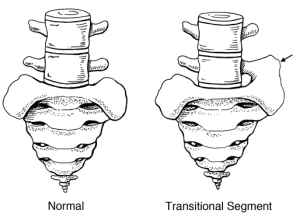

MedFriendly®


Transitional Lumbosacral Vertebrae
To understand what transitional lumbosacral vertebrae
means, it is necessary to understand the vertebrae.
Vertebrae are bones that form an opening in which the
spinal cord passes. The vertebrae are given different
names depending on the area of the body they are
located in. The lumbar vertebrae are in the area of the
lower back. There are five lumbar vertebrae, known as
L1 through L5, with L1 being above L2, L2 being above
L3, and so on.
FEATURED BOOK: The Lumbar Spine: Mechanical Diagnosis and Therapy
Below L5 are the sacral vertebrae. There are five sacral vertebrae, known as S1 through
S5, with S1 being above S2, S2 being above S3, and so on. In transitional lumbosacral
vertebrae, usually the last lumbar vertebra (L5) or the first sacral vertebra (S1) are
formed improperly. People are born with this condition. Normally, when the vertebrae
develop, they are clearly formed to represent different sections (for example, lumbar
vertebrae or sacral vertebrae). In transitional lumbosacral vertebrae, one of the
vertebrae does not form as part of the lumbar or sacral area. It is as if this one vertebra
cannot make up its mind whether to be become a lumbar vertebra or a sacral vertebra.
The result is that this vertebra winds up taking on characteristics of both the lumbar and
sacral vertebrae. In other word, it is like a combination of the two. This is where the term
transitional comes in because transitional means to be in a state of becoming something
else. Treatment of this condition can involve physical therapy to stretch the spine and
make it more stable.
"Where Medical Information is Easy to Understand"™
The use or a supportive brace to keep the back straight can also be
helpful. Such a brace is known as a lumbosacral orthosis. In rare
cases, corticosteroid injections can be used to treat associated
pain and discomfort. Corticosteroid drugs are a type of drug that
help to decrease inflammation. In very rare cases, surgery can be
performed to attempt to correct the problem. Transitional
lumbosacral vertebrae comes from the Latin word "transeo"
meaning "to go across," the Latin word "lumbus" meaning "loin," the
Latin word "sacer" meaning "sacred," and the Latin word "vertebra"
meaning "joint." Put the words together and you get "to go across
(the) loin sacred joint."















